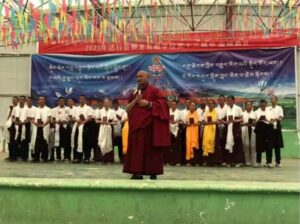
Co-founder Khandrul Jigme Kunsang Gyaltsen during 2020 graduation ceremony
Photo: RFA
Tibetans living in Tibet are losing their right, and the facilities to study in their native language in the face of the Chinese government’s systematic shutdown of schools whose primary medium of instruction was Tibetan. The latest school to be closed by the authorities was Sengdruk Taktse middle school in Darlak county of Golog in eastern Tibet on July 8. No official reason for the closure was given.
“The school’s primary language of instruction is Tibetan and it provides Tibetan culture-based learning for Tibetan students in the region. However, the officials have given the excuse of the requirement for monks to study in the monasteries instead of schools. The majority of the students and staff in the school are monks and tantric practitioners,” said a source speaking to the Tibet Watch, an independent UK-based organisation which works to promote human rights for the Tibetan people through monitoring, advocacy and research.
Sengdruk Taktse was first established as primary school, later receiving a license to become middle school in 2008.
Tibet Watch reports that earlier this year, on January 20, “the Director of the Legal Affairs Committee of the National People’s Congress, Shen Chungyao, announced that schools in “minority areas” were no longer allowed to teach their own languages, declaring such education to be ‘unconstitutional’. The statement was in clear contradiction to the founding provisions of the 1951 Bilingual Education law.”
Authorities are forcing the Tibetan students to enroll in government schools where the medium of instruction is Chinese. There are number of cases of arrests of intellectuals and scholars working on the survival of the Tibetan language, culture and identity, which adds weight to the widely-held conclusion that China is implementing a systematic strategy of eliminating Tibetan national identity. The language rights activist Tashi Wangchuk’s arrests and five year prison sentence is further evidence of this. Tashi was detained after giving an interview to the New York Times in 2015 where he spoke about his peaceful language advocacy to protect the Tibetan language. At no point did he advocate for, or mention, political separatism. He was charged with “inciting separatism”. His detention attracted international attention and calls for his release, which took place on January 28 this year.
A source speaking to Radio Free Asia revealed that since the end of 2020, many private Tibetan schools where Tibetan language and culture is taught have been shut down by the authorities in the Kardze Tibet Autonomous region.
Suppression of the Tibetan language continues in other forms.

Signs marking the national college entrance examination sites in Nagchu
Photo: HRW
A new edict regarding exam results, issued earlier this month by the Ministry of Education in the Malho, Tsolho and Yulshul Tibetan areas of Qinghai province, declared that equal weight will be given to the scores of Tibetan language exams to those of English and Chinese for Tibetan students sitting for the 2021 New School Admission Entrance Exam. In previous years, the Tibetan language scores were weighed more highly against other subjects which affects overall exam results and the subsequent placing of students for middle and high schools.
“Due to the requirement of a high score margin to gain admission to these national schools [the only schools that teach Tibetan], many Tibetan students who wish to enroll in them are not able to make it, instead, they have to enroll in schools where more than 90 percent of the instruction is in Chinese and that poses a long-term threat to the Tibetan language,” said Karma Tenzin, a researcher at the Tibet Policy Institute in Dharamsala, speaking to RFA.
A separate report from Human Rights Watch says that the Chinese language is now being used above the Tibetan language on signage in Tibet. Until recently, Tibetan always appeared above Chinese on all public signboards, notices, and banners but this has been reversed, according to HRW whose experts have studied photos from Tibet. There has been no official announcement; there is a legal requirement in place for bilingual signage.




 Print
Print Email
Email